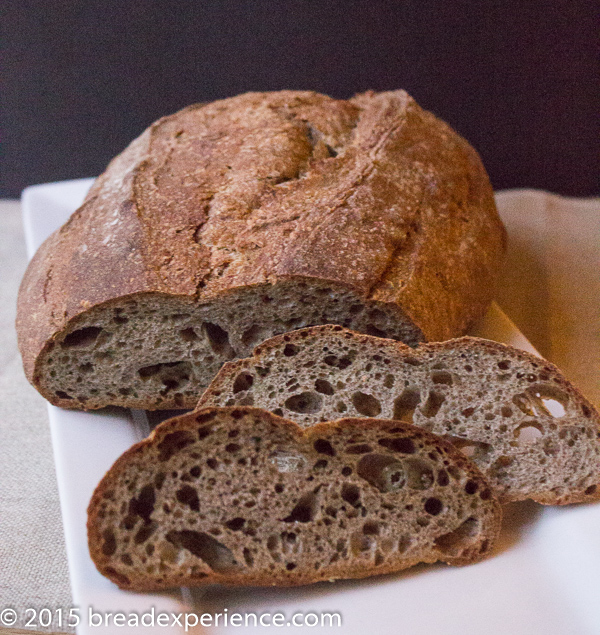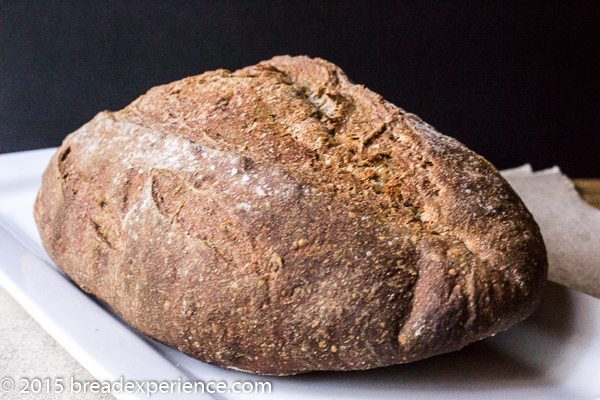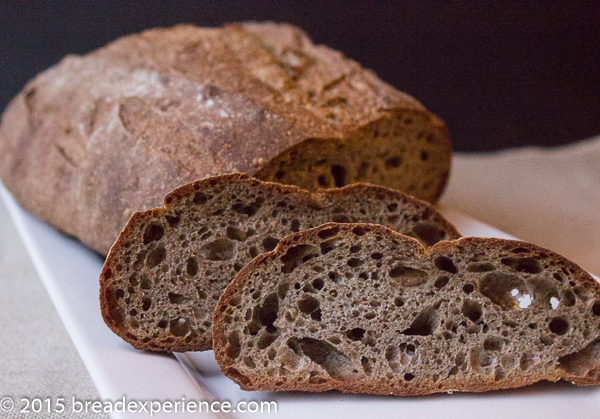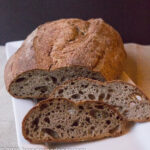This Sourdough Buckwheat Rye utilizes a 24-hour cold ferment in the refrigerator to strengthen the gluten and bring out the flavor of the bread.

I started working on this bread after attending the Maine Kneading Conference. I brought home one of Derek from Hootenanny’s loaves from the Artisan Bread Fair and enjoyed it so much I wanted to recreate it myself.
After my initial attempt, I got sidetracked with other bread projects, so this one sat on the back burner for a few weeks. But this past weekend, I revisited it and finally found the right proportions to achieve an open crumb with a texture that isn’t gummy or bitter.
Adjusting the Grain Percentages
While my Sourdough Buckwheat Rye isn’t the same as Derek’s loaf, I’m happy with how it turned out.
If I remember correctly, his version used about 40% buckwheat and rye combined. I started with 15% buckwheat and 25% rye but wasn’t satisfied with the result, so I gradually reduced the rye until I found a combination that suited my taste.
This formula is perfect for experimentation. Feel free to adjust the ratio of white flour to rye and buckwheat to match your preferences. I kept the hydration level between 60–65% for each trial, but you can tweak it if you like.
Just try not to change too many variables at once (something I’ve been guilty of!)—it can make troubleshooting difficult if the loaf doesn’t turn out as expected.
Why Use Buckwheat and Rye?
Buckwheat and rye aren’t just flavorful additions—they bring unique qualities to the bread:
- Buckwheat: Despite its name, buckwheat isn’t a wheat grain, making it gluten-free (though the bread itself isn’t gluten-free due to the wheat flour). Buckwheat adds a deep, earthy flavor and a darker crumb. It’s also rich in antioxidants, fiber, and essential minerals like magnesium and manganese.
- Rye: Rye flour contributes a slightly tangy taste and enhances moisture retention, giving the bread a longer shelf life. It also provides a hearty texture and pairs beautifully with the nutty notes from buckwheat.
Together, these grains create a loaf with a rich, complex flavor and a pleasantly chewy texture—perfect for sandwiches or enjoying on its own.

Troubleshooting Tips
Even experienced bakers run into challenges. Here are common issues and solutions for this bread:
Dense loaf?
- Double-check your fermentation times; underproofing is a common culprit.
- Make sure your starter is active and bubbly before mixing the dough.
Gummy texture?
- Extend the bake time slightly to ensure the crumb sets.
- Let the loaf cool completely before slicing—cutting too early can make the crumb seem gummy.
Flat loaf or poor oven spring?
- Ensure proper shaping and surface tension before proofing.
- Preheat your oven thoroughly and use steam (like adding ice cubes to a hot pan) to boost oven spring.
Crumb not as open as desired?
- Increase hydration slightly—but adjust carefully and incrementally.
- Be gentle during shaping to preserve the air bubbles formed during fermentation.
Substitution Ideas
Not everyone has rye or buckwheat flour on hand, so here are some alternatives:
- For buckwheat flour: Substitute with whole wheat, spelt, or einkorn flour for a similar nutty flavor. Be aware that these may absorb liquid differently—adjust hydration as needed.
- For rye flour: Use whole wheat flour if you prefer a milder tang or spelt flour for a softer texture.
- For the white flour base: You can experiment with bread flour for more structure or all-purpose flour for a lighter crumb.
Tip:
When trying substitutions, only change one ingredient at a time to understand how it affects the final loaf.

Fermentation Options
I found that a 24-hour cold bulk ferment in the refrigerator helped develop the flavor and improved the dough’s structure. After the cold ferment, let the dough warm up to room temperature for about an hour before shaping the loaf.
If you’re short on time, you can bake the loaf on the same day you mix the final dough. Just be sure to allow for a two-hour bulk ferment and another two-hour final proof after shaping.
Serving Suggestions
This Sourdough Buckwheat Rye pairs wonderfully with both sweet and savory toppings. Here are a few ideas to enjoy it:
Savory Options:
- Creamy cheeses like brie or goat cheese
- Smoked salmon with fresh dill and cream cheese
- Avocado with a sprinkle of sea salt and chili flakes
- Hearty stews or soups—perfect for dipping
Sweet Options:
- Butter with a drizzle of honey or maple syrup
- Homemade fig jam (my personal favorite!)
- Nut butters with sliced bananas or berries
This versatile loaf is delicious fresh, toasted, or even used in sandwiches.
Print
Sourdough Buckwheat Rye
- Yield: 1 loaf 1x
Description
This Sourdough Buckwheat Rye utilizes a 24-hour cold ferment in the refrigerator to strengthen the gluten structure and bring out the flavor of the bread.
Ingredients
Sourdough Build:
- 70 grams sourdough starter
- 70 grams all-purpose flour
- 70 grams warm water
Final Dough:
- 200 grams levain (all minus 10 grams)
- 260 grams all-purpose flour
- 80 grams whole grain rye flour
- 60 grams buckwheat flour
- 265 grams water
- 15 grams salt
Instructions
Sourdough Build:
- Add the sourdough starter to a medium bowl, pour in the warm water, and stir to break up the starter. Mix in the flour and incorporate thoroughly using a wooden spoon or Danish dough whisk. Cover the mixture and let it rest overnight at room temperature for 8 – 12 hours or until ripe.
Final Dough:
- The next day, mix the levain and all but 50 grams of the water in a large bowl. Add in the flours and stir or whisk the ingredients until thoroughly combined.
- Let the dough autolyse (rest) for 15- 20 minutes, then add in the salt and the additional 50 grams of water and mix until the salt is completely incorporated into the dough.
- Cover the bowl and let the dough bulk ferment for 2 hours. Fold the dough 2 times at 30-minute intervals during the first hour. Let the dough rest for the final hour. (At this point, you can continue with shaping the loaf or place it in the refrigerator overnight to cold ferment.) **See Notes**
- Shape the loaf into an oval shape or the shape of your choice and place it on parchment paper sprinkled with cornmeal. Alternately, place the dough in a brotform proofing basket sprinkled with rice flour. Let the loaf proof for 1-2 hours.
- At least 45 minutes before you plan to bake the loaf, preheat the oven to 450 degrees F. with a baking stone on the bottom rack and a steam pan or iron skillet on the top shelf.
- When the loaf is ready, score it down the middle or in the pattern of your choice and slide it and the parchment paper onto the preheated baking stone. Carefully add 4-5 ice cubes or boiling water to the steam pan and immediately close the door.
- Bake the loaf for 25-35 minutes. Partway through the bake cycle, remove the parchment paper and rotate the loaf for even browning. When done, the loaf should be browned and sound hollow when thumped on the bottom.
- Remove the loaf to a wire rack to cool completely before slicing and serving.
Notes
I found that a 24-hour cold bulk ferment in the refrigerator helped develop the flavor and improved the dough’s structure. After the cold ferment, let the dough warm up to room temperature for about an hour before shaping the loaf. If you’re short on time, you can bake the loaf on the same day you mix the final dough. Just be sure to allow for a two-hour bulk ferment and another two-hour final proof after shaping.
- Category: Rye, Buckwheat
- Method: Sourdough
Happy Baking! See you in the kitchen!
Cathy
Darlene Record says
Sounds awesome! Although I’ve mastered every kind of bread using yeast including sprouted grain, I’ve never had a successful sourdough even though I started the culture several times and had it for months! The bread tasted great but it wasn’t hokey enough because I didn’t master the process to keep it light & airy(full of holes)! And now it’s the only bread my husband can eat, but I hate the thought of eating soo much flour to keep the culture going and active! But I love the idea of buckwheat because it’s much healthier than straight wheat and I’m sure it’s delicious!!! Thank you for sharing!!
Cathy says
If you’ve mastered yeast breads, then you’re well on your way. If you haven’t achieved the coveted “holes” yet with sourdough, I wouldn’t worry about it. As long as the bread tastes good and your husband can eat it, that’s what is important.
Regarding using so much flour to maintain the starter, there are lots of ways to use discarded sourdough so it doesn’t go to waste. Here is a post with some ideas https://www.breadexperience.com/creative-uses-for-sourdough-starte/
Once you find your rhythm (with sourdough), and the starter is mature enough, you really don’t have to feed it that often so you won’t be using too much flour.
If you try this bread, do let me know how it goes.
Happy Baking!
Cathy
Cathy says
The introduction mentions a 24-hour cold proof but the recipe indicates only a 1-2 hour proofing. Can you explain?
Cathy says
The process for the cold ferment is listed in the notes (at the bottom of the recipe). There is a reference to ***See notes*** in #3 in the directions, but perhaps it’s not as clear as it could be. I will update the notes. Thank you for bringing this to my attention.
CM says
Hello and thanks. I bookmarked your recipe because I want to incorporate buckwheat flour into my sourdough bread. Wondering whether you have made this recipe using some whole wheat bread flour in place of some of the all purpose flour? I buy high extraction unifine whole wheat flour because I prefer to make a loaf with 50-60% whole grain, if possible.
AND, very appreciative that you do not publish email addresses.
Cathy says
Hallo,
I haven’t experimented using high extraction whole wheat flour with this loaf, but I think it could work, especially if its finely ground.
I would include a good proportion of white all-purpose flour as well to make sure the loaf has enough structure.
I’ve also found that if you use too much buckwheat, the texture of the crumb can get rather spongy.
If you try this loaf with the whole grain flour, do let me know how it goes.
Happy Baking!
Cathy